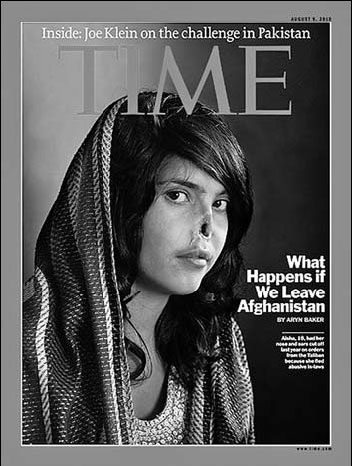'Afghan girl' cover image stirs debate
The face on the cover of Time magazine is graceful, composed and unthinkably maimed. The heart-shaped hole where 18-year-old Aisha's nose should be is a mark of Taliban justice - a visceral illustration, the headline suggests, of "what happens if we leave Afghanistan".'
 |
|
Time magazine picture tells graphic story of Taliban abuse |
The portrait quickly has become a symbol of the stakes of a nearly decade-old war. It has been brandished before House of Representatives Speaker Nancy Pelosi on television, dissected in online commentary and extrapolated into a conversation-starter about topics ranging from anti-abortion activism to violence against women.
If the response proves it still is possible for pictures to provoke a visually saturated culture, it also shows how much viewers have come to accept graphic images. Time braced for an outcry - even consulting psychologists about how the photo might affect children - but relatively little of the ensuing discussion focused on the graphic nature of the image.
Under orders from a Taliban commander acting as a judge, Aisha's nose and ears were sliced off last year as punishment for fleeing her husband's home, according to Time's story and other accounts. She said she fled to escape her in-laws' beatings and abuse.
Now in a women's shelter, she is set to get reconstructive surgery in the United States, with the help of Time, humanitarian organizations and others. She arrived in California on Thursday for a consulation with her surgeons.
Aisha posed for the Time cover photo because she wanted readers to see the potential consequences of a Taliban resurgence, the magazine said. Prominent Afghan women have expressed concerns that a potential government reconciliation with the insurgents could cost them freedoms they have gained since the 2001 US-led invasion toppled the former Taliban government.
ABC's This Week host Christiane Amanpour held it up and asked Pelosi about America's commitment to Afghan women as the United States weighs its future involvement in their country. Pelosi looked away before replying that educational and other goals for Afghanistan's women depend on establishing security and ending corruption.
The picture and story have elicited more than 500 comments on Time's website alone, plus countless others on social networks and websites ranging from the online newspaper The Huffington Post to BagNews, a forum for dissecting photography. While it is too early to gauge whether the piece affected the magazine's sales, it already has brought in more than twice as many e-mailed letters to the editor as hot-button issues usually generate, the magazine said.
"It's provoked a tremendous amount of conversation, which is exactly what we wanted," Time Managing Editor Richard Stengel said. "It both gets people's attention and kind of repels people's attention, but it commands you to look at it."
Some observers have invoked comparisons with one of photojournalism's most enduring images: the arresting, green-eyed refugee girl who appeared on National Geographic's cover in 1985 and became an emblem of Afghanistan's suffering under Soviet occupation.
But if Aisha is the new "Afghan girl," some feel she is being used as a poster child for a political message.
"It's not the photo," journalist Irin Carmon wrote on the feminist blog Jezebel. "It's the headline. ... There is an elision here between these women's oppression and what the US military presence can and should do about it."
At least some commentators, including some writing from Muslim perspectives, are troubled by the photo itself or its placement on the cover of a magazine with a 3.25 million-copy print circulation and a website that drew nearly 9 million unique US viewers last month.
Hofstra University anthropology professor Daniel Martin Varisco wrote on the Islam scholars' blog, Tabsir, that the cover photo is an "unfortunate example of sensationalized news reporting" that downplays the gains Afghan women have made.
Photojournalists have long grappled with how and when to use graphic pictures, balancing a belief in telling difficult truths with consideration for the sensitivities of the subjects and of readers.
Stengel said he deliberated at length about using Aisha's portrait, which was accompanied by an editor's note explaining his rationale and apologizing to readers who might object.
 0
0 






